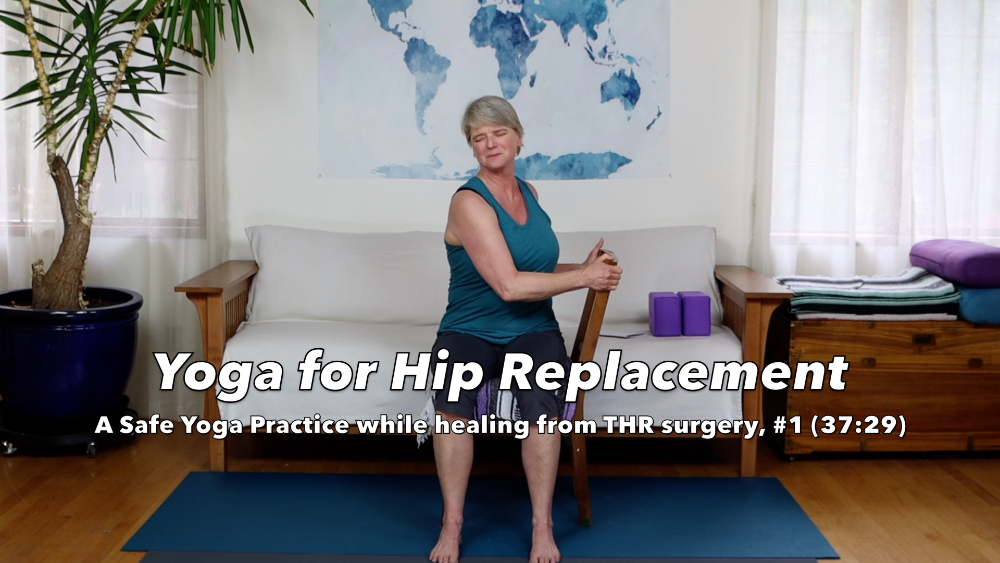 Following Total Hip Replacement surgery you want to give your body every opportunity to heal. This can take 6-12 weeks. Surgeons often give restrictions on movement for the first 6 weeks or so. Restrictions on movement are meant to protect your vulnerable new hip while the bones knit with the prostheses and while tissue heals.
Following Total Hip Replacement surgery you want to give your body every opportunity to heal. This can take 6-12 weeks. Surgeons often give restrictions on movement for the first 6 weeks or so. Restrictions on movement are meant to protect your vulnerable new hip while the bones knit with the prostheses and while tissue heals.
This is the time for plenty of restorative yoga, pranayama (breathing), and meditaiton. But some movement is important for healing and you may find yourself craving movement if you are feeling stiff from sitting all the time or tense because of pain. The key is to find what is safe, relaxing and what feels good; and because yoga is so adaptable there are always options.
Try these yoga practices in the 6-12 weeks following THR surgery and while you are healing or waiting for restrictions to be lifted. The Standing Practice helps to keep your leg muscles toned. The Chair Practice stretches and strengthens muscles in the trunk and releases tension. The Restorative Practice promotes relaxation and healing.
As you explore the poses below, go slow and focus intently on sensation. Stop if pain increases. Following a practice always rest in Corpse Pose/Savasana in your recliner, on a couch, or on your bed, and while you do, observe sensations and relax.
Standing Practice
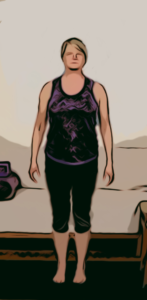
Mountain Pose/Tadasana – Do this pose with a walker or a countertop within easy reach. While practicing the pose be aware of how much weight you are putting on each foot and if or how you favor your surgery leg. Experiment with shifting forward onto the balls of your feet and then shifting back onto your heals. Then try shifting from side to side. Rest in Corpse Pose/Savasana. Do this daily and note any changes.
Practice isometrically contracting your hip stabilizing muscles while standing in Mountain Pose/Tadasana. This practice keeps your hips safe because you do not move your legs or feet, they stay in place while muscles isometrically contract around the hip joint. Rest in corpse pose following the practice.
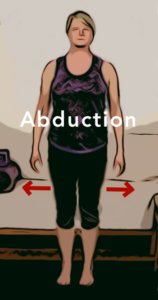
Abductors: keeping your feet planted on the floor, try to widen your legs to isometrically engage the muscles on the outside of your legs.
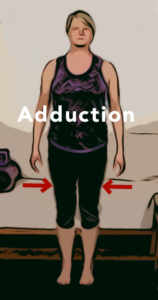
Adductors: Keeping your feet planted on the floor, try to draw your legs toward one another to isometrically contract the muscles on the inside of your legs.
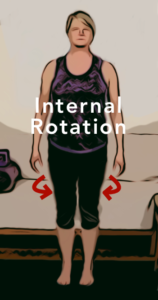
Internal Rotators: Keeping your feet planted on the floor, isometrically contract the muscles that externally rotate your legs.
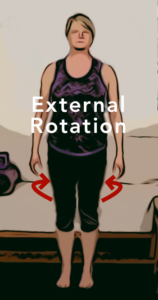
External Rotators: Keeping your feet planted on the floor, isometrically contract the muscles that externally rotate your legs.
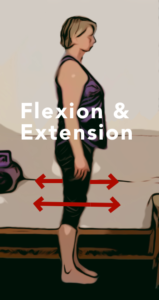
Hip Flexors and Extensors: Keeping your feet planted, push one foot forward and the other back. Alternate, isometrically contracting the muscles that move your legs forward and back, as though you are cross-country skiing
Members: Watch full-length video of Mountain Pose/Tadasana
Non-Members: Watch preview of full-length video Mountain Pose/Tadasana
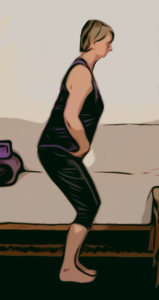
Chair Pose/Utkatasana: Start with mini movements down and up. Breathe in when you lower and breathe out when you rise up. Go slowly and stop if pain increases. This pose is great for keeping your hip stabilizing muscles toned. After a few repetitions, rest in Corpse Pose/Savasana in your lounge chair or bed to quietly take in sensations.
Members: Watch full-length video of Chair Pose/Utkatasana
Non-Members: Watch preview of full-length video Chair Pose/Utkatasana
Seated in a Chair Practice
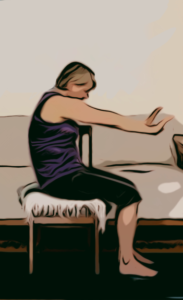 Cat Pose in a chair: Sit on a chair so that your sit bones are centered on the chair and so that you have room behind you for rounding your spine. Make sure that the seat of the chair is tall enough so that your pelvis is level with or higher than your knees (90°or greater angle between your thighs and pelvis). Exhale and tilt your pelvis back (posterior tilt) and round your spine back (spinal flexion) and press your arms forward. Pull your belly back toward your spine. Breathe and observe as you hold the pose. This stretches the muscles all through the back of your body and engages your core muscles. Rest and observe.
Cat Pose in a chair: Sit on a chair so that your sit bones are centered on the chair and so that you have room behind you for rounding your spine. Make sure that the seat of the chair is tall enough so that your pelvis is level with or higher than your knees (90°or greater angle between your thighs and pelvis). Exhale and tilt your pelvis back (posterior tilt) and round your spine back (spinal flexion) and press your arms forward. Pull your belly back toward your spine. Breathe and observe as you hold the pose. This stretches the muscles all through the back of your body and engages your core muscles. Rest and observe.
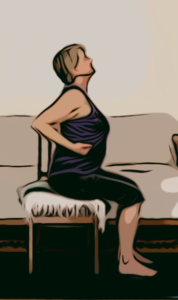 Cow Pose in a chair: Sit on a chair so that your sit bones are centered on the chair. Make sure that the seat of the chair is tall enough so that your pelvis is level with or higher than your knees (90°or greater angle between your thighs and pelvis). Keep your pelvis stationary while you inhale and lift through your upper back (spinal extension) and pull your arms back. Breathe and observe as you hold the pose. This stretches the front of the body and engages the muscles in the back. Note: During the 6-12 weeks while your hip is healing avoid tilting your pelvis forward (creating a less than 90° angle between your thighs and pelvis) in Cow Pose.
Cow Pose in a chair: Sit on a chair so that your sit bones are centered on the chair. Make sure that the seat of the chair is tall enough so that your pelvis is level with or higher than your knees (90°or greater angle between your thighs and pelvis). Keep your pelvis stationary while you inhale and lift through your upper back (spinal extension) and pull your arms back. Breathe and observe as you hold the pose. This stretches the front of the body and engages the muscles in the back. Note: During the 6-12 weeks while your hip is healing avoid tilting your pelvis forward (creating a less than 90° angle between your thighs and pelvis) in Cow Pose.
Practice both Cat Pose and Cow Pose by combining them. Inhale on Cat Pose and Exhale on Cow. Repeat several times and then rest.
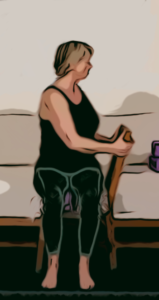
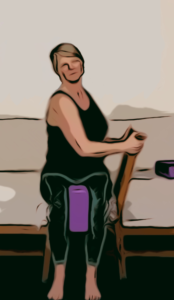 Twist in a chair: Sit on a chair with the back of the chair to your right side. Make sure the chair is tall enough so that your pelvis is level with or higher than your knees (90°or greater angle between your thighs and pelvis). Keep your pelvis and legs squared forward and turn your chest toward the back of the chair. You can use a block between your knees to help stabilize your leg/pelvis position. Hold the back of the chair with your hands and twist through your thoracic and cervical spine, breathe gently in and out and observe. Experiment with turning your head to the right and then to the left. Rest.
Twist in a chair: Sit on a chair with the back of the chair to your right side. Make sure the chair is tall enough so that your pelvis is level with or higher than your knees (90°or greater angle between your thighs and pelvis). Keep your pelvis and legs squared forward and turn your chest toward the back of the chair. You can use a block between your knees to help stabilize your leg/pelvis position. Hold the back of the chair with your hands and twist through your thoracic and cervical spine, breathe gently in and out and observe. Experiment with turning your head to the right and then to the left. Rest.
Restorative Practice: in a recliner, on a couch or on your bed
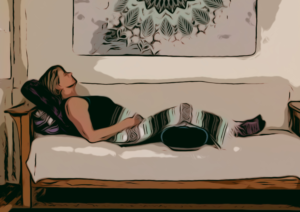 Corpse Pose/Savasana.
Corpse Pose/Savasana.
Set up: Lie on your bed, your couch, or in your recliner. Elevate your head a little and make sure your legs and hip(s) are as comfortable as possible. Try supporting them behind the knees with a pillow or bolster. Let your hands rest on your belly or let them rest at your sides. Close your eyes and take a moment to contemplate if your are comfortable. Make adjustments. It is worth taking time to find the most comfortable position so that you can stay for 10+ minutes and so that you have the best chances of fully relaxing.
Practice relaxing: Close your eyes and begin to observe your breath. With each exhale try to relax a little more deeply. If your mind wanders come back to observing your breath. Remain in Corpse Pose/Savasana for 10 minutes or for as long as you like! While you are recovering from THR this one of the best practices to promote healing, manage stress, and deal with pain.
Members: Watch full-length video of Corpse Pose/Savasana
Non-Members: Watch preview of full-length video Corpse Pose/Savasana
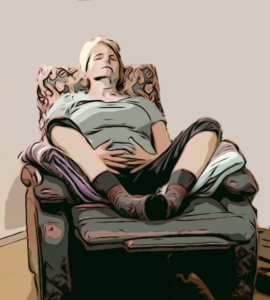 Reclining Bound Angle Pose/Supta Baddha Konasana
Reclining Bound Angle Pose/Supta Baddha Konasana
Set up: Lie on your bed, your couch, or in your recliner. Elevate your spine and head. Bring the bottoms of your feet together and let your knees begin to drop wide. Prop your legs in a comfortable position with bolsters or pillows or the arms of your recliner. Do not let your legs hang without support. You should feel no strain in your hips. Let your hands rest on your belly or let them rest at your sides. Close your eyes and take a moment to contemplate if your are comfortable. Make adjustments. It is worth taking time to find the most comfortable position so that you can stay in this position for 10+ minutes and so that you have the best chances of fully relaxing.
Practice relaxing: Close your eyes and begin to observe your breath. With each exhale try to relax a little more deeply. If your mind wanders come back to observing your breath. Remain in Reclining Bound Angle Pose/Supta Buddha Konasana for 10 minutes or for as long as you like!
Members: Watch full-length video of Reclining Bound Angle Pose/Supta Baddha Konasana
Non-Members: Watch preview of full-length video Reclining Bound Angle Pose/Supta Baddha Konasana
View Free full-Length video that accompanies this blog: Yoga while healing from Total Hip Replacement Surgery: A safe post-op asana practice – Free video
Here’s to Healthy and Happy Hips!
Become a member of Yoga for Hip Replacement here
Articles and Studies:
*Twelve-Minute Daily Yoga Regimen Reverses Osteoporotic Bone Loss
Muscular strength after total hip arthroplasty: A prospective comparison of 3 surgical approaches
Changes in Hip and Knee Muscle St
“This is your Brain on Mindfulness,” Shambhala Sun, Dr Michael Baime
“Yoga for Pain: What the Science Says,” NCCIH Clinical Digest
for Health Professionals
“The Science Of Yoga And Mindfulness For Pain with Dr. Sara Lazar, PhD,”
Integrative Pain Science Institute Podcast
